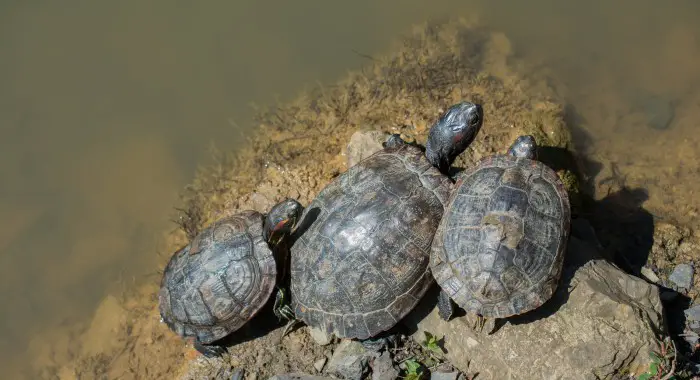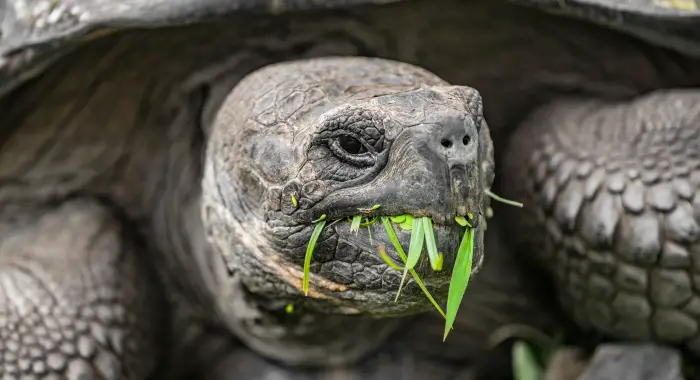Turtles, tortoises, and terrapins are three types of reptiles. They are very similar in appearance but differ in their habitats and behaviours.
All three terms are commonly used interchangeably. However, tortoise is the only one that has a specific scientific definition. Turtle and terrapin are both common names rather than scientific ones.
The word turtle comes from the Latin word tortus, meaning twisted or curved. Turtle shells are usually covered with bony plates called carapaces. These cover the head, neck, back, and tail. Most turtles live in water, although some species live on land.
A tortoise is a large terrestrial reptile with a shell covering its body. Its name comes from the Latin word torquis meaning crooked or twisted. Tortoises are found throughout the world except for Antarctica. They are essentially turtles who forgot how to swim. As a result, they walk on the tip of their toes.
As for terrapins, they are a type of aquatic turtle. They have long snouts and webbed feet and live in fresh water and mud.
So, while they have many things in common, turtles, tortoises, and terrapins differ in many ways as well. The world of chelonians is a fascinating one, filled with interesting information!
Similarities between turtles, tortoises, and terrapins
Turtles, tortoises, and terrapins all belong to the chelonian family.
They have the characteristic shell and are all cold-blooded. That means they may freeze to death when temperatures drop as they can’t maintain their body temperature on their own, which is why terrapins need a heat lamp to keep warm.
To help survive in colder climates, most members of the family can hibernate if necessary—although they won’t if the temperatures are mild. As a side note and technically speaking, cold-blooded creatures go into brumation rather than hibernation, as only warm-blooded animals such as bears hibernate. Turtles, for example, brumate by burrowing in the mud during the cooler months of the year.
One more thing all three members of the chelonian family have in common is that they all lay eggs, since they are all reptiles.
Finally, there is little differentiation when it comes to tails between terrapins, turtles, and tortoises. However, females have shorter and thinner tails than males.
This is where the common characteristics between turtles, tortoises, and terrapins end.
As for their differences, they are several and cover a surprising number of aspects, from where they live to what they eat and the shape of their shells.
Who lives on land and who is aquatic?
Tortoises live on land
Tortoises live on land. They don’t like water, nor do they know how to swim. They will go into the water up to their knees to clean up themselves and drink water, but if they go any deeper they risk drowning.
In effect, tortoises are turtles who have lost the ability to swim. This makes them exclusively terrestrial animals.
Turtles love the water
Turtles, on the other hand, like water. They are great swimmers and can’t survive for long on land. They only come out of the water to lay their eggs but don’t wait for the eggs to hatch. It is up to the hatchlings to make their way to the sea. Turtles are usually found out in the sea.
Terrapins are happy on land and in the water
Terrapins occupy an evolutionary space between tortoises and turtles. They live in freshwater areas such as ponds and streams but will happily live in slightly salty waters like a river delta. At the same time, they will be just as happy basking on a stone in the sun. Hence, terrapins are both aquatic and terrestrial.
Who is an omnivore and who is a herbivore?
Tortoises are herbivores
Tortoises are strictly herbivores. They enjoy a low-protein diet—indeed, too much protein is detrimental to their health.
They will eat any vegetation available around them, from cacti in arid lands to berries and weeds in more temperate climates.
Turtles and terrapins are omnivores
Turtles and terrapins are omnivores. They eat both meat and plants. Turtles, for example, will eat molluscs, jellyfish, algae, sponges, and seaweed, while terrapins add insects and other land fauna and flora to their diet.
Legs, flippers, and webbed feet
Tortoises have legs
Tortoises have stubby, short legs, and walk on their toes. Their legs are strong because they live on land and carry their shell, which is very heavy.
Terrapins have webbed feet
Terrapins have webbed feet that let them swim in the freshwater but also walk on land. Their feet have adapted to the versatility of the environments they choose to live in.
Unlike tortoises, terrapins walk with their full foot and not on their toes.
Turtles have flippers
Just like dolphins, turtles have flippers that help them swim very fast: they can reach up to 35 km/hour when they swim!
Dome shell vs. flat shell
Tortoises have dome shells
Tortoises have shells in the form of a dome. Their shell is hard and sturdy because it must protect them from attacks and predators.
When attacked, tortoises can retract in their shell almost completely. Their heavy shells make them slower to walk but also protect them very efficiently.
Turtles have flat shells
A heavy, domed shell would be very hard for turtles to swim with. As a result, turtles have flat shells which are lighter and don’t drag them in the water. Their shells are also flatter to help them swim better and easily glide in the water.
The shell of a turtle is not big enough for it to retract completely under—but gives it the flexibility it needs to zoom away from sea predators.
Turtles can grow quite big, reaching more than 1 metre long in adulthood. Size matters, as the bigger the animal, the easier it is to tolerate cool waters. While turtles like warm seas, their sheer size helps them withstand cooler waters as well.
Terrapins have their own shells
Because terrapins live both on land and in the water, their shell is more rounded than a turtle’s but flatter than a tortoise’s. They have fewer predators in the areas they live in, and their shell has adapted to both terrestrial and aquatic living.
How long do they live?
Tortoises outlive them all
Tortoises have a rather long lifespan, which ranges from 60 to 80 years on average.
Jonathan, the famous Seychelles tortoise is currently 190 years old. He is a member of the giant tortoise family.
Turtles almost live as much as humans
Turtles live between 60 and 70 years, on average.
Terrapins live the least
Terrapins live on average between 20 and 40 years. While it’s more than any dog or cat will ever live, their lifespan is on the shorter end of the chelonian family.
Where do they originate?
Tortoises are from all over the world, except Australia. There are plenty of tortoise species from Europe, America, Asia, Africa, and even the Pacific islands.
Originally, turtles emerged in South Africa, 250 million years ago.
Terrapins originate from northern America and were initially found from the east coast of the United States down to the Gulf of Mexico. The name ‘terrapin’ comes from the word ‘torope,’ which is a Native American word originating from the Algonquin tribe. It was the name the tribe gave to the terrapins they encountered.
Turtles, tortoises, and terrapins
All three members of the chelonian family are types of reptiles—cold-blooded animals that lack bones. However, they differ in size, lifespan, habitat, and behaviour. So, while many people use the terms turtles, tortoises, and terrapins interchangeably, you will now be able to tell the difference between them!
As for the UK, turtles are becoming more common in the seas surrounding the Isles and tortoises can be found almost anywhere in the countryside and even in urban gardens.
Terrapins are not original to the United Kingdom, though, and are considered by many to be an invasive species. They can be found in ponds in the wild or kept as pets. Terrapin owners who legally have terrapins can keep them but may not release them in the wild and the sale of terrapins is nowadays forbidden.
If you would love to give a good home to a poor unwanted pet terrapin, download for free the complete terrapin guide—a complete handbook with everything you need to know about looking after your very own pet terrapin.




